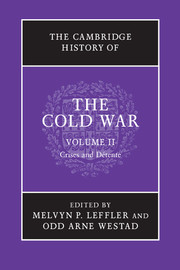Book contents
- Frontmatter
- 1 Grand strategies in the Cold War
- 2 Identity and the Cold War
- 3 Economic aspects of the Cold War, 1962–1975
- 4 The Cuban missile crisis
- 5 Nuclear competition in an era of stalemate, 1963–1975
- 6 US foreign policy from Kennedy to Johnson
- 7 Soviet foreign policy, 1962–1975
- 8 France, “Gaullism,” and the Cold War
- 9 European integration and the Cold War
- 10 Détente in Europe, 1962–1975
- 11 Eastern Europe: Stalinism to Solidarity
- 12 The Cold War and the transformation of the Mediterranean, 1960–1975
- 13 The Cold War in the Third World, 1963–1975
- 14 The Indochina wars and the Cold War, 1945–1975
- 15 The Cold War in the Middle East: Suez crisis to Camp David Accords
- 16 Cuba and the Cold War, 1959–1980
- 17 The Sino-Soviet split
- 18 Détente in the Nixon–Ford years, 1969–1976
- 19 Nuclear proliferation and non-proliferation during the Cold War
- 20 Intelligence in the Cold War
- 21 Reading, viewing, and tuning in to the Cold War
- 22 Counter-cultures: the rebellions against the Cold War order, 1965–1975
- 23 The structure of great power politics, 1963–1975
- 24 The Cold War and the social and economic history of the twentieth century
- Bibliographical essay
- Index
- References
11 - Eastern Europe: Stalinism to Solidarity
Published online by Cambridge University Press: 28 September 2010
- Frontmatter
- 1 Grand strategies in the Cold War
- 2 Identity and the Cold War
- 3 Economic aspects of the Cold War, 1962–1975
- 4 The Cuban missile crisis
- 5 Nuclear competition in an era of stalemate, 1963–1975
- 6 US foreign policy from Kennedy to Johnson
- 7 Soviet foreign policy, 1962–1975
- 8 France, “Gaullism,” and the Cold War
- 9 European integration and the Cold War
- 10 Détente in Europe, 1962–1975
- 11 Eastern Europe: Stalinism to Solidarity
- 12 The Cold War and the transformation of the Mediterranean, 1960–1975
- 13 The Cold War in the Third World, 1963–1975
- 14 The Indochina wars and the Cold War, 1945–1975
- 15 The Cold War in the Middle East: Suez crisis to Camp David Accords
- 16 Cuba and the Cold War, 1959–1980
- 17 The Sino-Soviet split
- 18 Détente in the Nixon–Ford years, 1969–1976
- 19 Nuclear proliferation and non-proliferation during the Cold War
- 20 Intelligence in the Cold War
- 21 Reading, viewing, and tuning in to the Cold War
- 22 Counter-cultures: the rebellions against the Cold War order, 1965–1975
- 23 The structure of great power politics, 1963–1975
- 24 The Cold War and the social and economic history of the twentieth century
- Bibliographical essay
- Index
- References
Summary
Suppression of the Hungarian uprising in 19561 gave Eastern Europe a harsh reminder of the ground rules operating within the Soviet bloc. First, member could leave the Warsaw Pact. Second, the states of Eastern Europe had to maintain a Communist monopoly at all times. These two principles were designed to prevent radical change within Eastern Europe. They secured Moscow’s geostrategic interests in the region by setting boundaries that could not be crossed. That did not prevent leaders from taking local initiatives should they so wish, but their willingness to do so differed markedly between countries.
The Polish leader Władysław Gomułka had been brought back to power in October 1956. One of his first external acts was to renegotiate Poland’s relations with the Soviet Union. Though the relationship remained subservient, a degree of formal sovereignty was restored. At home, he preserved the main domestic changes made during ‘October’: the return of agriculture to private hands and improved relations between Church and state. However, realising that the invasion of Hungary was a fate that Poland had missed perhaps by only a few days, he rejected any further reforms. Even modest proposals reintroduce market elements into central planning were dismissed as attempts to ‘undermine socialism’. Poland entered a decade of stagnation.
- Type
- Chapter
- Information
- The Cambridge History of the Cold War , pp. 219 - 237Publisher: Cambridge University PressPrint publication year: 2010
References
- 4
- Cited by

